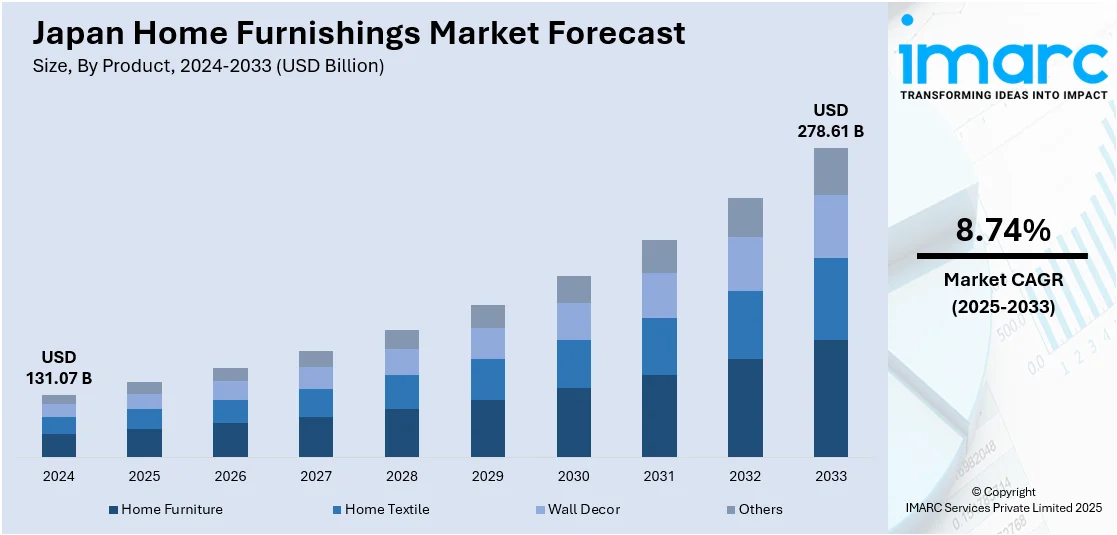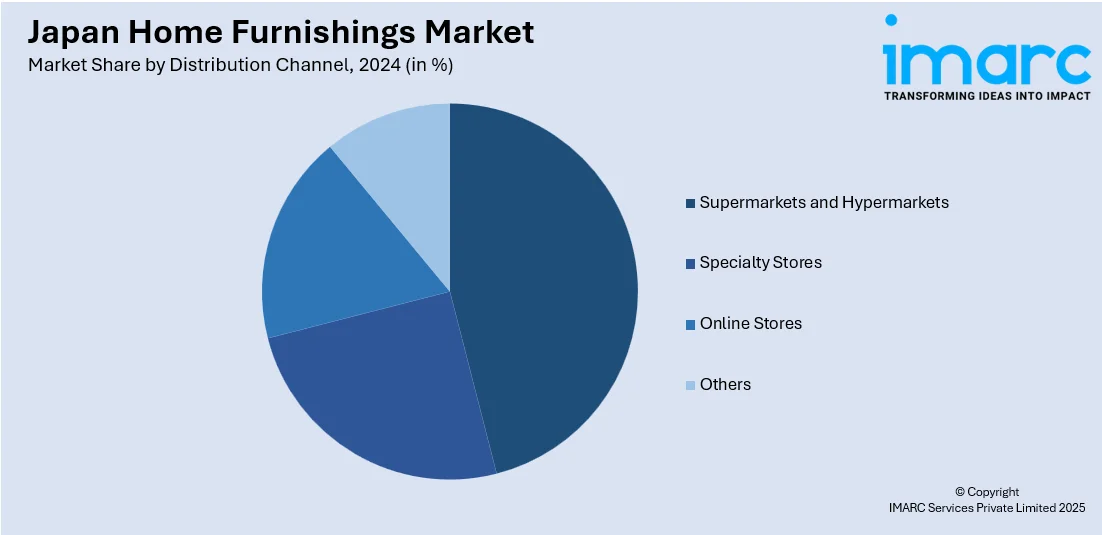
Japan Home Furnishings Market Size, Share, Trends and Forecast by Product, Price, Distribution Channel, and Region, 2025-2033
Japan Home Furnishings Market Overview:
The Japan home furnishings market size reached USD 131.07 Billion in 2024. Looking forward, IMARC Group expects the market to reach USD 278.61 Billion by 2033, exhibiting a growth rate (CAGR) of 8.74% during 2025-2033. The market is being driven by factors such as an aging population demanding ergonomic and accessible furniture, increasing urbanization leading to compact living spaces, growing preference for minimalist and multifunctional designs, rising disposable incomes, and the digital transformation of retail channels enhancing consumer access to customized home solutions.
|
Report Attribute
|
Key Statistics
|
|---|---|
|
Base Year
|
2024 |
|
Forecast Years
|
2025-2033
|
|
Historical Years
|
2019-2024
|
| Market Size in 2024 | USD 131.07 Billion |
| Market Forecast in 2033 | USD 278.61 Billion |
| Market Growth Rate 2025-2033 | 8.74% |
Japan Home Furnishings Market Trends:
Demographic Shift Toward an Aging Population
Japan is experiencing a rapid demographic shift, characterized by a swiftly aging population. The population share of those aged 65 and older is more than 29% as of 2025, and this figure is expected to increase in the decades to come. This population trend is fundamentally redefining the need for home furnishings, fueling an inclination towards products that enhance accessibility, safety, and comfort for elderly individuals. Furniture with design elements including ergonomic support, height adjustments, non-slip surfaces, and simple-to-understand mechanisms are becoming popular. Recliner chairs with lift-assist mechanisms, low-height beds, anti-fatigue mats, and support seating options are increasingly in demand. In addition to this, there is a growing interest in the production of modular and multi-functional furniture that can be reconfigured as individuals' mobility or health conditions change. Consumers are also investing in easier-to-clean and -maintain materials, appealing to both independent seniors and those who receive home care services.

Urbanization and Compact Living Spaces
Another underlying force driving the Japan home furnishings market is the continued urbanization, along with the prevalence of small living spaces. Tokyo, Osaka, and Yokohama are among the world's most densely populated cities. Consequently, residential units, especially apartments and condominiums, are small, with average floor areas well below global norms. This spatial limitation has created a strong demand for space-efficient, multi-functional, and modular furniture products. Furniture with multipurpose functions—like sofas that turn into beds, fold-down dining tables, wall desks, or storage units under the bed—are in greater demand. There is also growing demand for stack chairs, folding stools, and wheeled furniture to make it easier to set up room arrangements with flexibility. Japanese consumers are also especially attracted to streamlined, minimalist styles that maximize the feeling of openness and tidiness in small spaces. This trend has also created a niche of custom-designed furniture adapted to unique floor plans, especially in cities. Moreover, foreign brands expanding into the Japanese market are frequently forced to localize their products to accommodate these spatial preferences.
Japan Home Furnishings Market Segmentation:
IMARC Group provides an analysis of the key trends in each segment of the market, along with forecasts at the region/country level for 2025-2033. Our report has categorized the market based on product, price, and distribution channel.
Product Insights:
- Home Furniture
- Home Textile
- Wall Decor
- Others
The report has provided a detailed breakup and analysis of the market based on the product. This includes home furniture, home textile, wall decor, and others.
Price Insights:
- Mass
- Premium
A detailed breakup and analysis of the market based on the price have also been provided in the report. This includes mass and premium.
Distribution Channel Insights:

- Supermarkets and Hypermarkets
- Specialty Stores
- Online Stores
- Others
The report has provided a detailed breakup and analysis of the market based on the distribution channel. This includes supermarkets and hypermarkets, specialty stores, online stores, and others.
Regional Insights:
- Kanto Region
- Kansai/Kinki Region
- Central/Chubu Region
- Kyushu-Okinawa Region
- Tohoku Region
- Chugoku Region
- Hokkaido Region
- Shikoku Region
The report has also provided a comprehensive analysis of all the major regional markets, which include Kanto Region, Kansai/Kinki Region, Central/Chubu Region, Kyushu-Okinawa Region, Tohoku Region, Chugoku Region, Hokkaido Region, and Shikoku Region.
Competitive Landscape:
The market research report has also provided a comprehensive analysis of the competitive landscape. Competitive analysis such as market structure, key player positioning, top winning strategies, competitive dashboard, and company evaluation quadrant has been covered in the report. Also, detailed profiles of all major companies have been provided.
Japan Home Furnishings Market News:
- October 2024: Sumitomo Corporation invested in Social Interior Inc., a Japanese firm offering digital solutions for furniture procurement and home furnishings. Social Interior's Business Management Cloud platform streamlines furniture selection and ordering for businesses, while its Subsclife service provides consumers with subscription-based access to furniture and appliances. This partnership aims to modernize the home furnishings industry through digital transformation.
- August 2024: IKEA reopened its Shibuya store in Tokyo with a renewed focus on home furnishings tailored for urban living. The revamped seven-floor layout features themed sections, such as Living Room & Dining Room, Kitchen, Office, and Bedroom & Bathroom, each showcasing coordinated furniture and interior goods.
Japan Home Furnishings Market Report Coverage:
| Report Features | Details |
|---|---|
| Base Year of the Analysis | 2024 |
| Historical Period | 2019-2024 |
| Forecast Period | 2025-2033 |
| Units | Billion USD |
| Scope of the Report |
Exploration of Historical Trends and Market Outlook, Industry Catalysts and Challenges, Segment-Wise Historical and Future Market Assessment:
|
| Products Covered | Home Furniture, Home Textile, Wall Decor, Others |
| Prices Covered | Mass, Premium |
| Distribution Channels Covered | Supermarkets and Hypermarkets, Specialty Stores, Online Stores, Others |
| Regions Covered | Kanto Region, Kansai/Kinki Region, Central/Chubu Region, Kyushu-Okinawa Region, Tohoku Region, Chugoku Region, Hokkaido Region, Shikoku Region |
| Customization Scope | 10% Free Customization |
| Post-Sale Analyst Support | 10-12 Weeks |
| Delivery Format | PDF and Excel through Email (We can also provide the editable version of the report in PPT/Word format on special request) |
Key Questions Answered in This Report:
- How has the Japan home furnishings market performed so far and how will it perform in the coming years?
- What is the breakup of the Japan home furnishings market on the basis of product?
- What is the breakup of the Japan home furnishings market on the basis of price?
- What is the breakup of the Japan home furnishings market on the basis of distribution channel?
- What is the breakup of the Japan home furnishings market on the basis of region?
- What are the various stages in the value chain of the Japan home furnishings market?
- What are the key driving factors and challenges in the Japan home furnishings market?
- What is the structure of the Japan home furnishings market and who are the key players?
- What is the degree of competition in the Japan home furnishings market?
Key Benefits for Stakeholders:
- IMARC’s industry report offers a comprehensive quantitative analysis of various market segments, historical and current market trends, market forecasts, and dynamics of the Japan home furnishings market from 2019-2033.
- The research report provides the latest information on the market drivers, challenges, and opportunities in the Japan home furnishings market.
- Porter's five forces analysis assist stakeholders in assessing the impact of new entrants, competitive rivalry, supplier power, buyer power, and the threat of substitution. It helps stakeholders to analyze the level of competition within the Japan home furnishings industry and its attractiveness.
- Competitive landscape allows stakeholders to understand their competitive environment and provides an insight into the current positions of key players in the market.
Need more help?
- Speak to our experienced analysts for insights on the current market scenarios.
- Include additional segments and countries to customize the report as per your requirement.
- Gain an unparalleled competitive advantage in your domain by understanding how to utilize the report and positively impacting your operations and revenue.
- For further assistance, please connect with our analysts.
 Request Customization
Request Customization
 Speak to an Analyst
Speak to an Analyst
 Request Brochure
Request Brochure
 Inquire Before Buying
Inquire Before Buying




.webp)




.webp)












